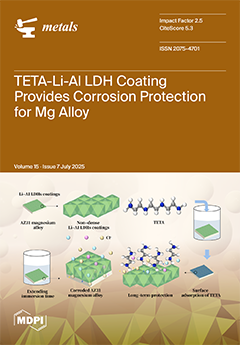In the industrial practice of metal forming, the consistent and reasonable characterization of the material behavior under the coupling effect of strain, strain rate, and temperature on the material flow stress is very important for the design and optimization of process parameters. The
[...] Read more.
In the industrial practice of metal forming, the consistent and reasonable characterization of the material behavior under the coupling effect of strain, strain rate, and temperature on the material flow stress is very important for the design and optimization of process parameters. The purpose of this work was to establish an appropriate constitutive model to characterize the rheological behavior of a hot-formed steel plate (22MnB5 steel) produced through the TSCR (Thin Slab Casting and Rolling) process under practical deformation temperatures (150–250 °C) and strain rates (0.001–3000 s
−1). Subsequently, the material flow behavior was modeled and predicted using the Johnson–Cook flow stress constitutive model. In this study, uniaxial tensile tests were conducted on 22MnB5 steel at room temperature under varying strain rates, along with elevated-temperature tensile tests at different strain rates, to obtain the engineering stress–strain curves and analyze the mechanical properties under various conditions. The results show that during room-temperature tensile testing within the strain rate range of 10
−3 to 300 s
−1, the 22MnB5 steel exhibited overall yield strength and tensile strength of approximately 1500 MPa, and uniform elongation and fracture elongation of about 7% and 12%, respectively. When the strain rate reached 1000–3000 s
−1, the yield strength and tensile strength were approximately 2000 MPa, while the uniform elongation and fracture elongation were about 6% and 10%, respectively. Based on the experimental results, a modified Johnson–Cook constitutive model was developed and calibrated. Compared with the original model, the modified Johnson–Cook model exhibited a higher coefficient of determination (
R2), indicating improved fitting accuracy. In addition, to predict the material’s damage behavior, three distinct specimen geometries were designed for quasi-static strain rate uniaxial tensile testing at ambient temperature. The Johnson–Cook failure criterion was implemented, with its constitutive parameters calibrated through integrated finite element analysis to establish the damage model. The determined damage parameters from this investigation can be effectively implemented in metal forming simulations, providing valuable predictive capabilities regarding workpiece material performance.
Full article





